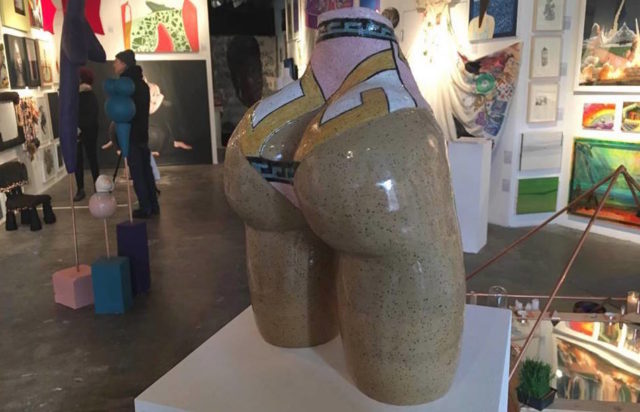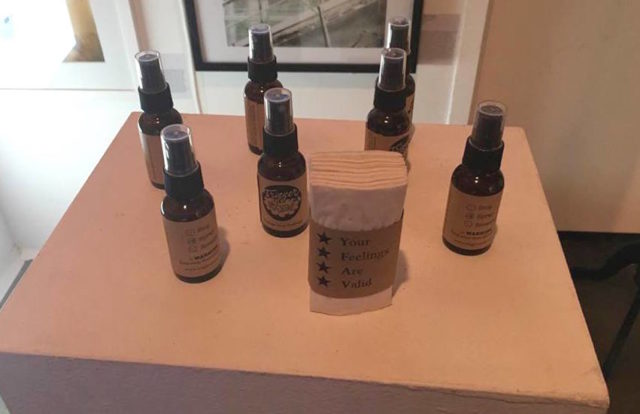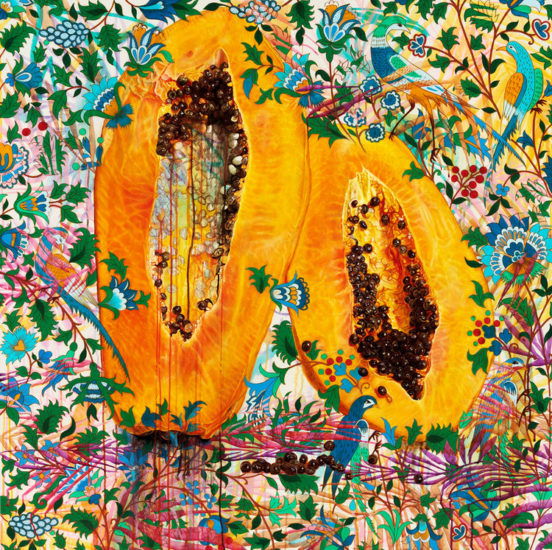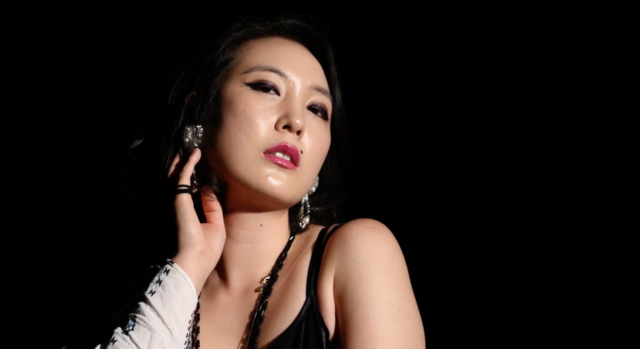
Meegan Barnes’s Peek-a-boo Versace Booty at the 2017 Whitney Houston Biennial (photo by author)
The Whitney Houston Biennial: Greatest Love Of All
Chashama
325 West Broadway
New York, NY
On view until March 29, 2017
Seven small spray bottles labeled “Trigger Spray” and a packet of tissues emblazoned with “Your Feelings Are Valid” sit on a pedestal in a back corner of the Whitney Houston Biennial at Chashama. In a silly sendup of trigger warnings and safe spaces, the corresponding label for the work by Elana Langer lists humor along with the other materials. As it turns out, this isn’t just an ingredient in Langer’s piece. Humor is key to many of the all-women group show’s inclusions, which felt like a breath of fresh air with the doom and gloom of both the Whitney Biennial and the daily outrage of the Trump administration.
The 2017 Whitney Houston Biennial: The Greatest Love Of All is the second incarnation of the biennial, launched in 2014 in response to the lack of gender equality in the Whitney Biennial, as well as other major exhibitions. While likely not intentional, this year’s Whitney Houston Biennial provides a relieving remedy for the darkness in the Whitney’s exhibition (as exemplified by Jordan Wolfson’s Real Violence). Here, the most compelling inclusions employed wit, satire and cheekiness to bolster political and feminist critiques. Even when not laugh-out-loud funny, there was a much-needed lightness that was in short supply at the Whitney.

Elana Langer, Trigger Spray, 2017, bottle, label, aromatherapy spray and humor (photo by author)
This year’s biennial, curated by artist C. Finley, ballooned from 2014’s 85 artists to 125. This difference in scope is, while in a different location than its previous incarnation, immediately apparent by its maniacal hanging. Walking up the rose petal-strewn stairs, I had to pause and orient myself for a minute, momentarily destabilized by a seemingly endless barrage of artwork. The salon-style hanging looked almost like a blanket of artwork draped over the entire space. Barely any white wall was visible. Adding to this visual assault, each work’s wall label also included some reading–a short text by the artist about a female pioneer that inspired them from Adrian Piper to Grandma Moses to an artist’s mother.
Once I got acclimated to the overwhelming amount of art, I noticed Kira Nam Greene’s tropical painting of two papayas on a colorful patterned background. Titled Grab It By The Papaya, Greene’s painting not only provided a twist on Trump’s notorious pussy-grabbing comment, but it also hinted at the papaya’s vaginal qualities. The painting, particularly in the context of its title, humorously references the long legacy in feminist art of using food as a stand-in for the body as seen in works like Marilyn Minter’s 100 Food Porn paintings.

Kira Nam Greene, Grab It By The Papaya, 2016, oil, flashe and acrylic on canvas (Courtesy the artist and Whitney Houston Biennial)
Like Grab It By The Papaya, many of the works in the Whitney Houston Biennial depicted the female body in some manner. This isn’t exactly a surprise since the body is one of feminist art’s enduring and increasingly tired tropes. Some works, like Kate Rubens’s painting Origin Of The Universe, fit this cliché with a hackneyed take on Gustave Courbet’s art historical classic. Other than a feminine perspective, the painting didn’t really add anything to the original or the feminist use of the body.
Other works, though, approached the use of the female body with a fresh and witty perspective. Take, for example, Meegan Barnes’s Peek-a-Boo Versace Booty, a small sculpture depicting a comparatively giant butt in a tiny pastel bikini. It’s reminiscent of Nicki Minaj’s much-envied buns (or even, Beyoncé’s who Barnes lists as her chosen female pioneer). While conceptually simplistic, Peek-a-Boo Versace Booty still felt, especially raised on a pedestal, like a monument to big booties–a body positive ode to the ass.

Chanel Matsunami Govreau and Lip J, Midnight Work, 2016, Video (Courtesy the artists and Whitney Houston Biennial)
While Barnes’ sculpture showed off the idealized curvy body as interpreted by a woman artist, Chanel Matsunami Govreau and Lip J’s video Midnight Work taunted viewers by refusing to reveal subjects’ bodies. The video presents dancers, clad in black outfits, waacking–a disco dance that came out of communities of color in Los Angeles in the 1970s and has now been revived in South Korea. Waacking, at least through the videos I later watched on YouTube, is similar to voguing with quick, sharp moves. But, viewers wouldn’t know that from Midnight Work, which only focuses a tight shot on the dancers’ faces. The only way viewers pick up on the dancer’s movements is through the loud cheers, screams and outburst from the crowd. While all the dancer’s expressions are undeniably fierce and piercing, the video coyly denies the viewers the privilege of gazing at the dancer’s bodies.
Midnight Work successfully upsets the power dynamic between viewer and artistic subject. Conversely, Rachel Mason’s FutureClown’s Inaugural Address just depicts upsetting power. Mason, in the guise of her terrifying clown character FutureClown, lip-synchs Donald Trump’s already unsettling inauguration speech. Mason rolls her eyes and gestures to the audience, pointing to the clownishness of Trump’s authoritative body language.

Rachel Mason, “FutureClown’s Inaugural Address,” 2017, Video (Courtesy the artist and Whitney Houston Biennial)
While I saw Mason’s video in bits and pieces before (it was livestreamed on AFC on Inauguration Day), watching it in the Whitney Houston Biennial gave it a completely different, and perhaps more satirical, context. The comically small size of the monitor trivialized the harsh rhetoric of his speech. Like viral Tiny Trump memes or references to the President’s itty-bitty hands, the miniature TV shrunk Trump’s overblown ego down to size. Like the tiniest dictator, his words were dwarfed by the surrounding female creativity in Chashama.
That creativity and lightheartedness ultimately made the show’s success. The country seems in a particularly unstable moment due to the possibility that 24 million people might lose their health care in the repeal of the American Care Act by an administration that could have been colluding with the Russians. The mental and emotional stress that impacts on citizens is not insignificant. In that context, the 2017 Whitney Houston Biennial not only reminds viewers how important humor can be, but it also stands as an example of the role art can play as both a vehicle for critique and an antidote, however temporary to our politically-driven depression and anxiety.


Comments on this entry are closed.